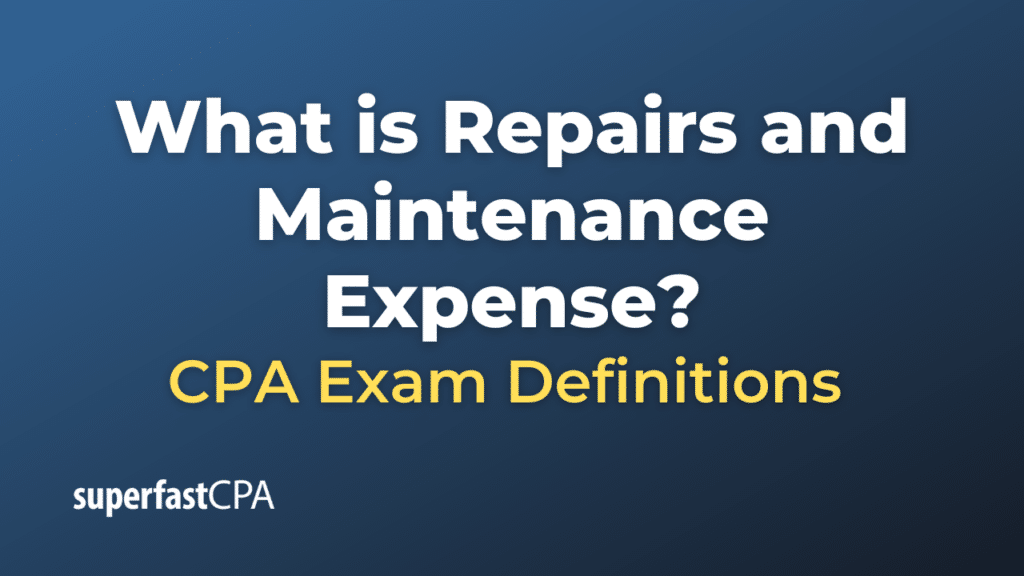Repairs and Maintenance Expense
Repairs and Maintenance Expense refers to the costs incurred by a business to ensure that its assets continue to operate in their intended manner over their useful life. These costs do not extend the useful life of the asset or improve its functionality beyond its original condition; if they did, they would be capitalized and added to the asset’s value on the balance sheet.
Key points about Repairs and Maintenance Expense:
- Expense vs. Capitalize:
- Repairs and Maintenance Expense is immediately recognized on the income statement in the period it is incurred.
- In contrast, costs that extend the life of an asset or improve its capacity (capital expenditures) are capitalized and then depreciated over the improved asset’s new useful life.
- Regular and Recurring: These are typically routine actions taken to maintain assets in working order, such as oil changes for vehicles, software updates, or replacing worn-out parts in machinery.
- Tax Implications: Since these expenses are necessary for a business’s ongoing operations, they are usually tax-deductible in the year they are incurred.
- Not Just Physical Assets: While we often think of repairs and maintenance in terms of tangible assets like equipment or buildings, the concept also applies to intangible assets. For example, periodic updates to software to fix bugs would be considered a maintenance expense.
- budgeting: Many companies budget for repairs and maintenance expenses, especially if they rely heavily on equipment or machinery in their operations. Planning for these expenses can help avoid unexpected financial strains.
In financial accounting and reporting, distinguishing between repairs and maintenance expenses and capital expenditures is crucial. Proper classification ensures accurate financial statements, which in turn provides stakeholders with a clear picture of a company’s financial health and its asset management practices.
Example of Repairs and Maintenance Expense
Let’s use a fictional scenario involving a company and its assets.
Sunny’s Delivery Service is a small business that provides parcel delivery in a metropolitan area. The company owns a fleet of 10 delivery vans. To keep these vans in top working condition, Sunny ensures regular maintenance and occasionally faces repair needs.
- Routine Maintenance:
- Every three months, each van undergoes an oil change, tire rotation, and general inspection.
- The total cost for all vans is $1,500.
- This cost is recorded as a Repairs and Maintenance Expense on Sunny’s income statement for that quarter since it’s a routine action to maintain the vans in their existing condition.
- Unexpected Repair:
- One day, a van breaks down due to a malfunctioning alternator.
- The cost to replace the alternator and get the van running again is $400.
- Just like the routine maintenance, this repair doesn’t extend the van’s life beyond its original expectancy or improve its functionality. Thus, the $400 is also recorded as a Repairs and Maintenance Expense.
- Upgrade (Capital Expenditure):
- Sunny decides to upgrade five of the vans with a new navigation system to improve delivery efficiency. This system wasn’t present in the vans originally.
- The total cost for these upgrades is $5,000.
- Because this upgrade improves the vans’ functionality and potentially extends their useful life in the business, this cost is capitalized. The $5,000 is added to the value of the vans on the balance sheet and will be depreciated over the expected life of the navigation systems.
At the end of the year, Sunny’s income statement will show Repairs and Maintenance Expense that includes the routine maintenance costs and the unexpected repair costs. Meanwhile, the balance sheet will reflect an increased value in the fleet of delivery vans due to the capitalized cost of the navigation systems.
This example illustrates the distinction between regular repairs and maintenance, which are expensed, and capital improvements, which are capitalized.













